masks2d.scad
This file provides 2D masking shapes that you can use with edge_profile() to mask edges.
The shapes include the simple roundover and chamfer as well as more elaborate shapes
like the cove and ogee found in furniture and architecture. You can make the masks
as geometry or as 2D paths.
To use, add the following lines to the beginning of your file:
include <BOSL2/std.scad>
-
Section: 2D Masking Shapes
-
mask2d_roundover()– Creates a circular mask shape for rounding edges or beading. [Geom] [Path] -
mask2d_teardrop()– Creates a 2D teardrop shape with specified max angle from vertical. [Geom] [Path] -
mask2d_cove()– Creates a 2D cove (quarter-round) mask shape. [Geom] [Path] -
mask2d_chamfer()– Produces a 2D chamfer mask shape. [Geom] [Path] -
mask2d_rabbet()– Creates a rabbet mask shape. [Geom] [Path] -
mask2d_dovetail()– Creates a 2D dovetail mask shape. [Geom] [Path] -
mask2d_ogee()– Creates a 2D ogee mask shape. [Geom] [Path]
-
Synopsis: Creates a circular mask shape for rounding edges or beading. [Geom] [Path]
Topics: Shapes (2D), Paths (2D), Path Generators, Attachable, Masks (2D)
See Also: corner_profile(), edge_profile(), face_profile(), fillet()
Usage: As module
- mask2d_roundover(r|d=|h=|height=|cut=|joint=, [inset], [mask_angle], [excess], [flat_top=], [quarter_round=]) [ATTACHMENTS];
Usage: As function
- path = mask2d_roundover(r|d=|h=|height=|cut=|joint=, [inset], [mask_angle], [excess], [flat_top=], [quarter_round=]);
Description:
Creates a 2D roundover/bead mask shape that is useful for extruding into a 3D mask for an edge. Conversely, you can use that same extruded shape to make an interior fillet between two walls. As a 2D mask, this is designed to be differenced away from the edge of a shape that with its corner at the origin and one edge on the X+ axis and the other mask_angle degrees counterclockwise from the X+ axis. If called as a function, returns a 2D path of the outline of the mask shape.
The roundover can be specified by radius, diameter, height, cut, or joint length.

If you need roundings to agree on edges of different mask_angle, e.g. to round the base of a prismoid, then you need all of the
masks used to have the same height. (Note that it may appear that matching joint would also work, but it does not because the joint distances are measured
in different directions.) You can get the same height by setting the height parameter, which is an alternate way to control the size of the rounding.
You can also set quarter_round=true, which creates a rounding that uses a quarter circle of the specified radius for all mask angles. If you have set inset
you will need flat_top=true as well. Note that this is the default if you use quarter_round=true but not otherwise. Generally if you want a roundover
results are best using the height option but if you want a bead as you get using inset the results are often best using the quarter_round=true option.
Arguments:
| By Position | What it does |
|---|---|
r |
Radius of the roundover. |
inset |
Optional bead inset size, perpendicular to the two edges. Scalar or 2-vector. Default: 0 |
mask_angle |
Number of degrees in the corner angle to mask. Default: 90 |
excess |
Extra amount of mask shape to creates on the X and quasi-Y sides of the shape. Default: 0.01 |
| By Name | What it does |
|---|---|
d |
Diameter of the roundover. |
h / height
|
Mask height excluding inset and excess. Give instead of r / d, cut or joint when you want a consistent mask height, no matter what the mask angle. |
cut |
Cut distance. IE: How much of the corner to cut off. See Types of Roundovers. |
joint |
Joint distance. IE: How far from the edge the roundover should start. See Types of Roundovers. |
flat_top |
If true, the top inset of the mask will be horizontal instead of angled by the mask_angle. Default: true if quarter_round is set, false otherwise. |
quarter_round |
If true, make a roundover independent of the mask_angle, defined based on a quarter circle of the specified size. Creates mask with angle-independent height. Default: false. |
anchor |
Translate so anchor point is at origin (0,0,0). See anchor. Default: CENTER
|
spin |
Rotate this many degrees around the Z axis after anchor. See spin. Default: 0
|
Side Effects:
- Tags the children with "remove" (and hence sets
$tag) if no tag is already set.
Example 1: 2D Roundover Mask by Radius
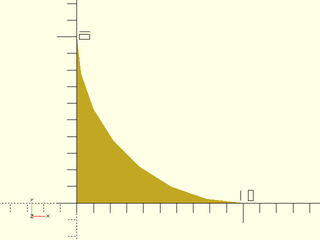
include <BOSL2/std.scad>
mask2d_roundover(r=10);
Example 2: 2D Bead Mask
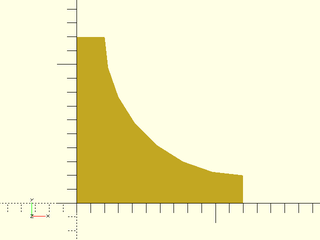
include <BOSL2/std.scad>
mask2d_roundover(r=10,inset=2);
Example 3: 2D Roundover Mask by Radius, acute angle
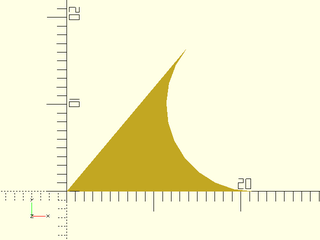
include <BOSL2/std.scad>
mask2d_roundover(r=10, mask_angle=50);
Example 4: 2D Bead Mask by Radius, acute angle
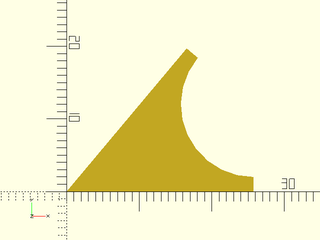
include <BOSL2/std.scad>
mask2d_roundover(r=10, inset=2, mask_angle=50);
Example 5: 2D Bead Mask for obtuse angle, by height
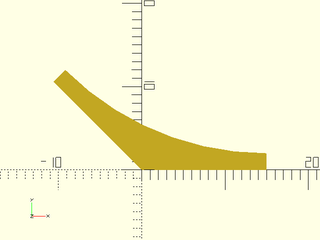
include <BOSL2/std.scad>
mask2d_roundover(h=10, inset=2, mask_angle=135, $fn=64);
Example 6: 2D Bead Mask for obtuse angle, by height with flat top
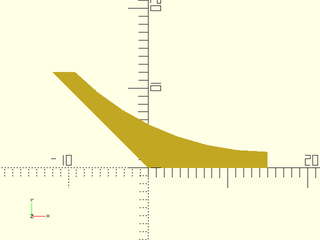
include <BOSL2/std.scad>
mask2d_roundover(h=10, inset=2, mask_angle=135, flat_top=true, $fn=64);
Example 7: 2D Angled Bead Mask by Joint Length. Joint length does not include the inset.
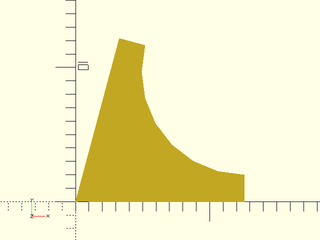
include <BOSL2/std.scad>
mask2d_roundover(joint=10, inset=2, mask_angle=75);
Example 8: Increasing the Excess
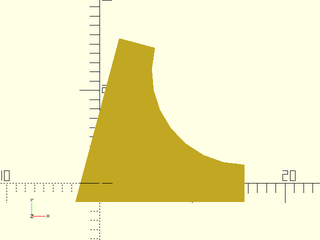
include <BOSL2/std.scad>
mask2d_roundover(r=10, inset=2, mask_angle=75, excess=2);
Example 9: quarter_round bead on an acute angle
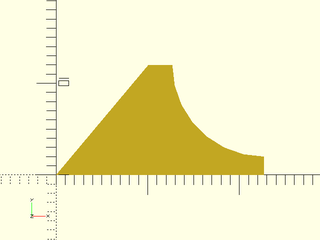
include <BOSL2/std.scad>
mask2d_roundover(r=10, inset=2, mask_angle=50, quarter_round=true);
Example 10: quarter_round bead on an obtuse angle
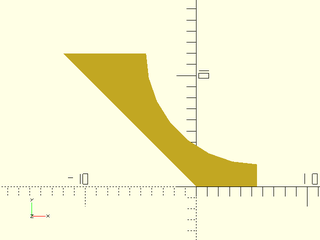
include <BOSL2/std.scad>
mask2d_roundover(r=10, inset=2, mask_angle=135, quarter_round=true);
Example 11: Masking by Edge Attachment
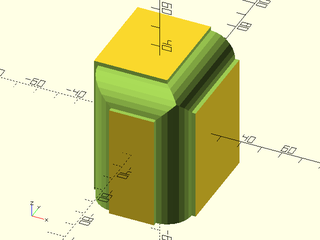
include <BOSL2/std.scad>
diff()
cube([50,60,70],center=true)
edge_profile([TOP,"Z"],except=[BACK,TOP+LEFT])
mask2d_roundover(h=12, inset=2);
Example 12: Making an interior fillet
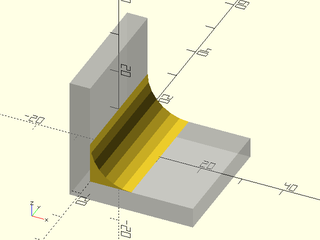
include <BOSL2/std.scad>
%render() difference() {
move(-[5,0,5]) cube(30, anchor=BOT+LEFT);
cube(310, anchor=BOT+LEFT);
}
xrot(90)
linear_extrude(height=30, center=true)
mask2d_roundover(r=10);
Example 13: Rounding over top of an extreme prismoid using height option
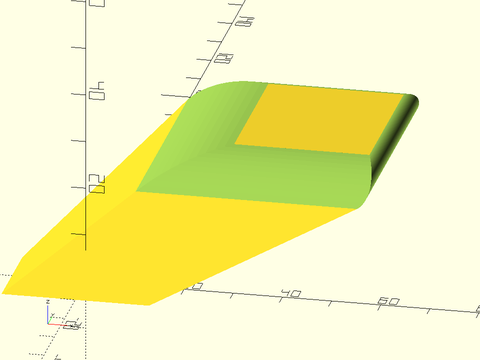
include <BOSL2/std.scad>
diff()
prismoid([30,20], [50,60], h=20, shift=[40,50])
edge_profile(TOP, excess=27)
mask2d_roundover(height=5, mask_angle=$edge_angle, $fn=128);
Example 14: Using the quarter_round option results in a lip on obtuse angles, so it may not be the best choice for pure roundings.
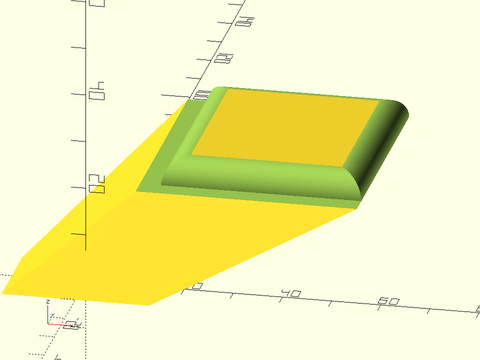
include <BOSL2/std.scad>
diff()
prismoid([30,20], [50,60], h=20, shift=[40,50])
edge_profile(TOP, excess=27)
mask2d_roundover(r=5, mask_angle=$edge_angle, quarter_round=true, $fn=128);
Example 15: Creating a bead on the prismoid using the height option with flat_top=true:

include <BOSL2/std.scad>
diff()
prismoid([30,20], [50,60], h=20, shift=[40,50])
edge_profile(TOP, excess=27)
mask2d_roundover(height=5, mask_angle=$edge_angle, inset=1.5, flat_top=true, $fn=128);
Example 16: Bead may be more pleasing using the quarter_round option, with curves terminating in a plane parallel to the prismoid top. The size of the inset edge will be larger than requested when the angle is obtuse.

include <BOSL2/std.scad>
diff()
prismoid([30,20], [50,60], h=20, shift=[40,50])
edge_profile(TOP, excess=27)
mask2d_roundover(r=5, mask_angle=$edge_angle, quarter_round=true, inset=1.5, $fn=128);
Synopsis: Creates a 2D teardrop shape with specified max angle from vertical. [Geom] [Path]
Topics: Shapes (2D), Paths (2D), Path Generators, Attachable, Masks (2D), FDM Optimized
See Also: corner_profile(), edge_profile(), face_profile()
Usage: As Module
- mask2d_teardrop(r|d=, [angle], [inset] [mask_angle], [excess], [cut=], [joint=], [h=|height=]) [ATTACHMENTS];
Usage: As Function
- path = mask2d_teardrop(r|d=, [angle], [inset], [mask_angle], [excess], [cut=], [joint=], [h=|height=]);
Description:
Creates a 2D teardrop mask shape that is useful for extruding into a 3D mask for an edge.
Conversely, you can use that same extruded shape to make an interior teardrop fillet between two walls.
As a 2D mask, this is designed to be differenced away from the edge of a shape that with its corner at the origin and one edge on the X+ axis and the other mask_angle degrees counterclockwise from the X+ axis.
If called as a function, returns a 2D path of the outline of the mask shape.
This is particularly useful to make partially rounded bottoms, that don't need support to print.
The roundover can be specified by radius, diameter, height, cut, or joint length.

Arguments:
| By Position | What it does |
|---|---|
r |
Radius of the rounding. |
angle |
The angle from vertical of the flat section. Must be between mask_angle-90 and 90 degrees. Default: 45. |
inset |
Optional bead inset size perpendicular to edges. Default: 0 |
mask_angle |
Number of degrees in the corner angle to mask. Default: 90 |
excess |
Extra amount of mask shape to creates on the X- and Y- sides of the shape. Default: 0.01 |
| By Name | What it does |
|---|---|
d |
Diameter of the rounding. |
h / height
|
Mask height excluding inset and excess. Given instead of r or d when you want a consistent mask height, no matter what the mask angle. |
cut |
Cut distance. IE: How much of the corner to cut off. See Types of Roundovers. |
joint |
Joint distance. IE: How far from the edge the roundover should start. See Types of Roundovers. |
flat_top |
If true, the top inset of the mask will be horizontal instead of angled by the mask_angle. Default: true. |
anchor |
Translate so anchor point is at origin (0,0,0). See anchor. Default: CENTER
|
spin |
Rotate this many degrees around the Z axis after anchor. See spin. Default: 0
|
Side Effects:
- Tags the children with "remove" (and hence sets
$tag) if no tag is already set.
Example 1: 2D Teardrop Mask
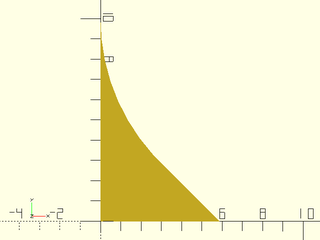
include <BOSL2/std.scad>
mask2d_teardrop(r=10,$fn=64);
Example 2: 2D Teardrop Mask for acute angle
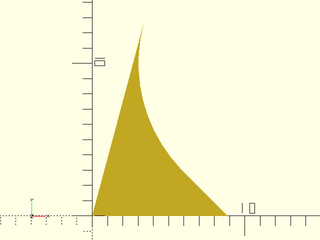
include <BOSL2/std.scad>
mask2d_teardrop(r=10, mask_angle=75,$fn=64);
Example 3: 2D Teardrop Mask for obtuse angle, specifying height
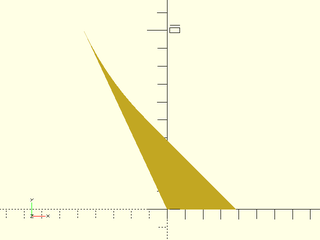
include <BOSL2/std.scad>
mask2d_teardrop(h=10, mask_angle=115,$fn=128);
Example 4: Increasing Excess
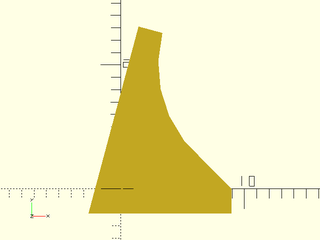
include <BOSL2/std.scad>
mask2d_teardrop(r=10, mask_angle=75, excess=2);
Example 5: Using a Custom Angle
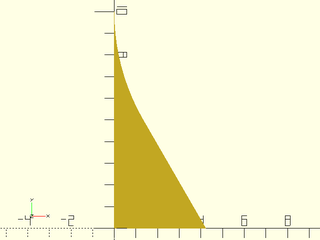
include <BOSL2/std.scad>
mask2d_teardrop(r=10,angle=30,$fn=128);
Example 6: With an acute mask_angle you can choose an angle of zero:
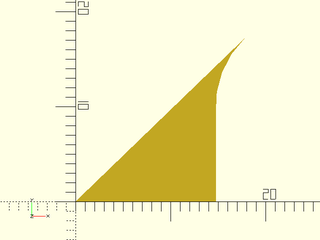
include <BOSL2/std.scad>
mask2d_teardrop(r=10,mask_angle=44,angle=0);
Example 7: With an acute mask_angle you can even choose a negative angle
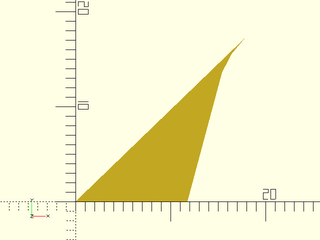
include <BOSL2/std.scad>
mask2d_teardrop(r=10,mask_angle=44,angle=-15);
Example 8: With an obtuse angle you need to choose a larger angle. Here we add inset.
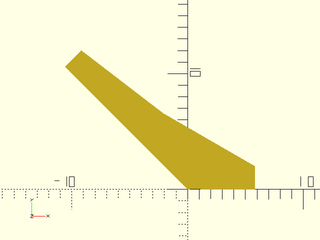
include <BOSL2/std.scad>
mask2d_teardrop(h=10, mask_angle=135,angle=60, inset=2);
Example 9: Same thing with flat_top=true.

include <BOSL2/std.scad>
mask2d_teardrop(h=10, mask_angle=135,angle=60, inset=2, flat_top=true);
Example 10: Masking by Edge Attachment
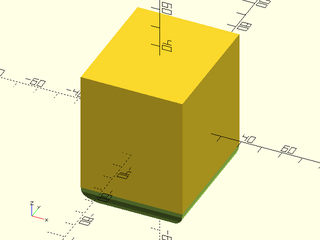
include <BOSL2/std.scad>
diff()
cube([50,60,70],center=true)
edge_profile(BOT)
mask2d_teardrop(r=10, angle=40);
Example 11: Making an interior teardrop fillet
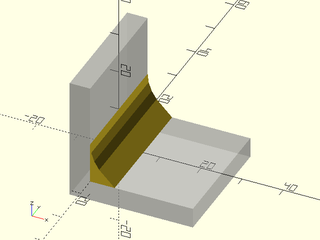
include <BOSL2/std.scad>
%render() difference() {
move(-[5,0,5]) cube(30, anchor=BOT+LEFT);
cube(310, anchor=BOT+LEFT);
}
xrot(90)
linear_extrude(height=30, center=true)
mask2d_teardrop(r=10);
Synopsis: Creates a 2D cove (quarter-round) mask shape. [Geom] [Path]
Topics: Shapes (2D), Paths (2D), Path Generators, Attachable, Masks (2D)
See Also: corner_profile(), edge_profile(), face_profile()
Usage: As module
- mask2d_cove(r|d=|h=|height=, [inset], [mask_angle], [excess], [bulge=], [flat_top=], [quarter_round=]) [ATTACHMENTS];
Usage: As function
- path = mask2d_cove(r|d=|h=, [inset], [mask_angle], [excess], [bulge=], [flat_top=]);
Description:
Creates a 2D cove mask shape that is useful for extruding into a 3D mask for an edge. Conversely, you can use that same extruded shape to make an interior rounded shelf decoration between two walls. As a 2D mask, this is designed to be differenced away from the edge of a shape that with its corner at the origin and one edge on the X+ axis and the other mask_angle degrees counterclockwise from the X+ axis. If called as a function, returns a 2D path of the outline of the mask shape.
If you need coves to agree on edges of different mask_angle, e.g. on the top of a prismoid, then you need all of the
masks used to have the same height. You can get the same height by setting the height parameter. For obtuse angles, however, the cove mask may not
have is maximum height at the edge, which means it won't mate with adjacent coves. You can fix this using flat_top=true which extends the circle
with a line to maintain a flat top. Another way to fix it is to set bulge. You can also achieve constant height using the quarter_round= option,
which uses a quarter circle of the specified size for all mask_angle values. This option often produces a nice result because coves all terminate in a
plane at 90 degrees.
Arguments:
| By Position | What it does |
|---|---|
r |
Radius of the cove. |
inset |
Optional amount to inset in the perpendicular direction from the edges. Scalar or 2-vector. Default: 0 |
mask_angle |
Number of degrees in the corner angle to mask. Default: 90 |
excess |
Extra amount of mask shape to creates on the X and quasi-Y sides of the shape. Default: 0.01 |
| By Name | What it does |
|---|---|
d |
Diameter of the cove. |
h / height
|
Mask height, excluding inset and excess. Given instead of r or d when you want a consistent mask height, no matter what the mask angle. |
bulge |
specify arc as the distance away from a straight line chamfer. The arc will not meet the sides at a 90 deg angle. |
quarter_round |
If true, make cove independent of the mask_angle, defined based on a quarter circle, with angle-independent radius. The mask will have constant height. Default: false. |
flat_top |
If true, the top inset of the mask will be horizontal instead of angled by the mask_angle. In the case of obtuse angles force the mask to have a flat section at its left side instead of a circular arc. Default: true if quarter_round is set, false otherwise. |
anchor |
Translate so anchor point is at origin (0,0,0). See anchor. Default: CENTER
|
spin |
Rotate this many degrees around the Z axis after anchor. See spin. Default: 0
|
Side Effects:
- Tags the children with "remove" (and hence sets
$tag) if no tag is already set.
Example 1: 2D Cove Mask by Radius

include <BOSL2/std.scad>
mask2d_cove(r=10);
Example 2: 2D Inset Cove Mask (not much different than a regular cove of larger radius)
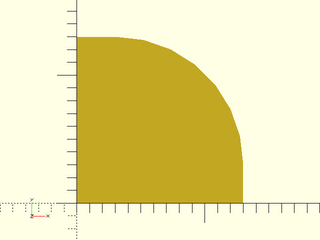
include <BOSL2/std.scad>
mask2d_cove(r=10,inset=3);
Example 3: 2D Cove Mask for acute angle, specified by height, with the bulge set to change the curve. Note that the circular arc is not perpendicular to the sides.
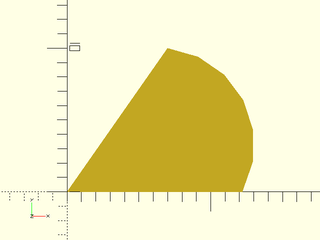
include <BOSL2/std.scad>
mask2d_cove(h=10,mask_angle=55, bulge=3);
Example 4: 2D Cove Mask for obtuse angle, specified by height. This will produce an odd result if combined with other masks because the maximum height is in the middle.
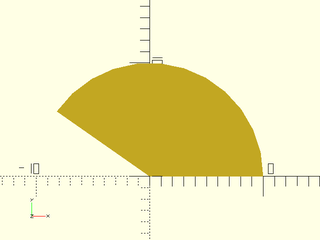
include <BOSL2/std.scad>
mask2d_cove(h=10,mask_angle=145);
Example 5: 2D Cove Mask for obtuse angle with flat top. This is one solution to the problem of the previous example. Max height is achieved at the left corner.

include <BOSL2/std.scad>
mask2d_cove(h=10,mask_angle=145,flat_top=true);
Example 6: 2D Cove Mask for obtuse angle, specified by height with bulge parameter. Another way to fix the problem of the previous example: the max height is again achieved at the left corner.
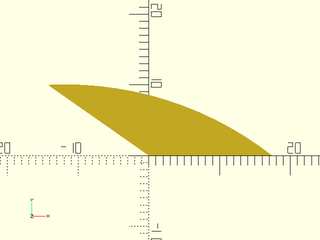
include <BOSL2/std.scad>
mask2d_cove(h=10,mask_angle=145, bulge=3, $fn=128);
Example 7: 2D Cove Mask for acute angle with quarter_round enabled
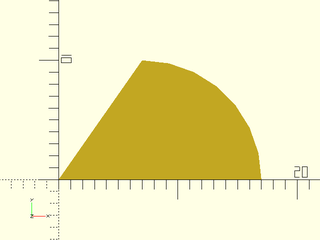
include <BOSL2/std.scad>
mask2d_cove(r=10,mask_angle=55,quarter_round=true);
Example 8: 2D Cove Mask for obtuse angle, specified by height. Note that flat_top is on by default in quarter_round mode.
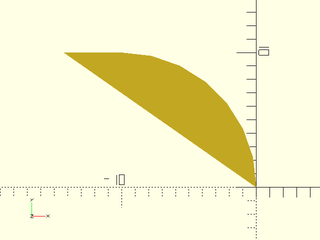
include <BOSL2/std.scad>
mask2d_cove(r=10,mask_angle=145,quarter_round=true);
Example 9: Increasing the Excess
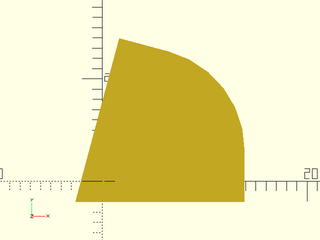
include <BOSL2/std.scad>
mask2d_cove(r=10,inset=3,mask_angle=75, excess=2);
Example 10: Masking by Edge Attachment
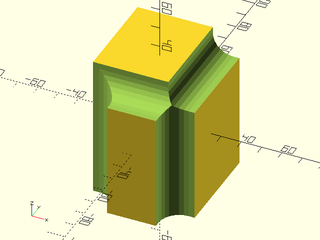
include <BOSL2/std.scad>
diff()
cube([50,60,70],center=true)
edge_profile([TOP,"Z"],except=[BACK,TOP+LEFT])
mask2d_cove(h=10, inset=3);
Example 11: Making an interior rounded shelf
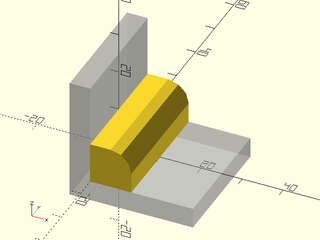
include <BOSL2/std.scad>
%render() difference() {
move(-[5,0,5]) cube(30, anchor=BOT+LEFT);
cube(310, anchor=BOT+LEFT);
}
xrot(90)
linear_extrude(height=30, center=true)
mask2d_cove(r=5, inset=5);
Example 12: A cove on top of an extreme prismoid top by setting height and using flat_top mode. This creates long flat tops sections at obtuse angles.
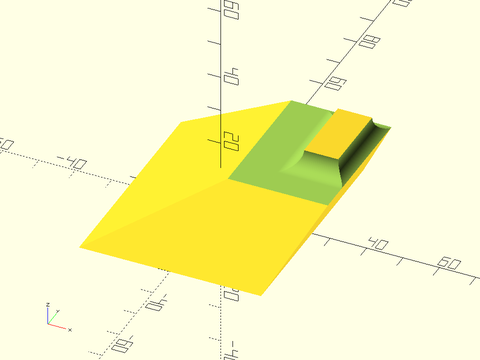
include <BOSL2/std.scad>
diff()
prismoid([50,60], [20,30], h=20, shift=[25,16])
edge_profile(TOP, excess=20)
mask2d_cove(h=5, inset=0, mask_angle=$edge_angle, flat_top=true, $fn=128);
Example 13: Cove on an extreme prismoid top by setting height and bulge. Obtuse angles have long curved sections.
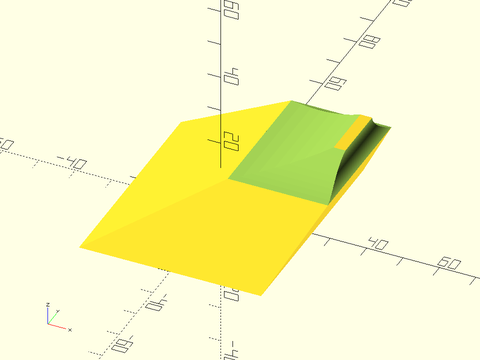
include <BOSL2/std.scad>
diff()
prismoid([50,60], [20,30], h=20, shift=[25,16])
edge_profile(TOP, excess=20)
mask2d_cove(h=5, inset=0, mask_angle=$edge_angle, bulge=1, $fn=128);
Example 14: Rounding an extreme prismoid top using quarter_round. Another way to handle this situation.
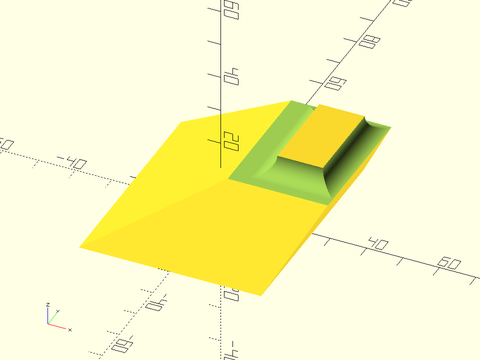
include <BOSL2/std.scad>
diff()
prismoid([50,60], [20,30], h=20, shift=[25,16])
edge_profile(TOP, excess=20)
mask2d_cove(r=5, inset=0, mask_angle=$edge_angle, quarter_round=true, $fn=128);
Synopsis: Produces a 2D chamfer mask shape. [Geom] [Path]
Topics: Shapes (2D), Paths (2D), Path Generators, Attachable, Masks (2D)
See Also: corner_profile(), edge_profile(), face_profile()
Usage: As Module
- mask2d_chamfer(edge, [angle], [inset], [excess]) [ATTACHMENTS];
- mask2d_chamfer(y=, [angle=], [inset=], [excess=]) [ATTACHMENTS];
- mask2d_chamfer(x=, [angle=], [inset=], [excess=]) [ATTACHMENTS];
Usage: As Function
- path = mask2d_chamfer(edge, [angle], [inset], [excess]);
- path = mask2d_chamfer(y=, [angle=], [inset=], [excess=]);
- path = mask2d_chamfer(x=, [angle=], [inset=], [excess=]);
Description:
Creates a 2D chamfer mask shape that is useful for extruding into a 3D mask for an edge. Conversely, you can use that same extruded shape to make an interior chamfer between two walls. As a 2D mask, this is designed to be differenced away from the edge of a shape that with its corner at the origin and one edge on the X+ axis and the other mask_angle degrees counterclockwise from the X+ axis. If called as a function, returns a 2D path of the outline of the mask shape. The edge parameter specifies the length of the chamfer's slanted edge. The x parameter specifies the width. The y parameter specfies the length of the non-horizontal arm of the chamfer. The height specifies the height of the chamfer independent of angle. You can specify any combination of parameters that determines a chamfer geometry.
Arguments:
| By Position | What it does |
|---|---|
edge |
The length of the edge of the chamfer. |
angle |
The angle of the chamfer edge, away from vertical. Default: mask_angle/2. |
inset |
Optional amount to inset perpendicular to each edge. Scalar or 2-vector. Default: 0 |
mask_angle |
Number of degrees in the corner angle to mask. Default: 90 |
excess |
Extra amount of mask shape to creates on the X- and Y- sides of the shape. Default: 0.01 |
| By Name | What it does |
|---|---|
x |
The width of the chamfer (joint distance in x direction) |
y |
The set-back (joint distance) in the non-x direction of the chamfer. |
h / height
|
The height of the chamfer (excluding inset and excess). |
w / width
|
The width of the chamfer (excluding inset and excess). |
quarter_round |
If true, make a roundover independent of the mask_angle, defined based on a 90 deg angle, with a constant height. Default: false. |
flat_top |
If true, the top inset of the mask will be horizontal instead of angled by the mask_angle. Default: true. |
anchor |
Translate so anchor point is at origin (0,0,0). See anchor. Default: CENTER
|
spin |
Rotate this many degrees around the Z axis after anchor. See spin. Default: 0
|
Side Effects:
- Tags the children with "remove" (and hence sets
$tag) if no tag is already set.
Example 1: 2D Chamfer Mask, at 45 deg by default
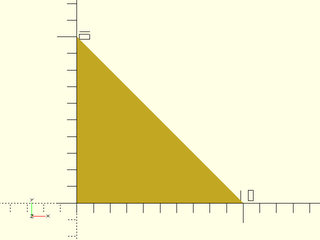
include <BOSL2/std.scad>
mask2d_chamfer(x=10);
Example 2: 2D Chamfer Mask, at 30 deg (measured down from vertical)
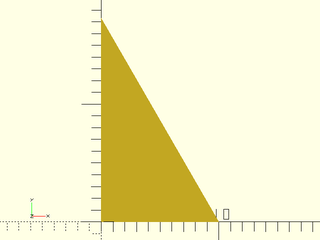
include <BOSL2/std.scad>
mask2d_chamfer(x=10,angle=30);
Example 3: 2D Chamfer Mask on an acute angle. The default chamfer angle is to produce a symmetric chamfer.
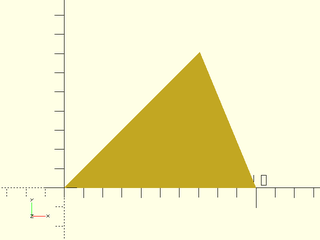
include <BOSL2/std.scad>
mask2d_chamfer(x=10,mask_angle=45);
Example 4: 2D Chamfer Mask on an acute angle. Here we specify the angle of the chamfer

include <BOSL2/std.scad>
mask2d_chamfer(x=10,mask_angle=45,angle=45);
Example 5: 2D Chamfer Mask specified by x and y length
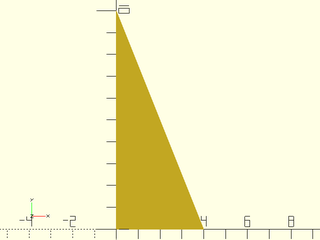
include <BOSL2/std.scad>
mask2d_chamfer(x=4,y=10);
Example 6: 2D Chamfer Mask specified by x and y length. The y length is along the top side of the chamfer, not parallel to the Y axis.

include <BOSL2/std.scad>
mask2d_chamfer(x=4,y=5,mask_angle=44);
Example 7: 2D Chamfer Mask specified by width and height.
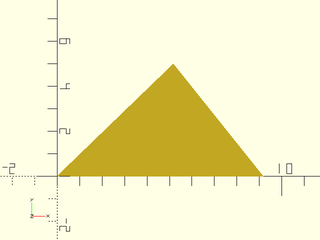
include <BOSL2/std.scad>
mask2d_chamfer(w=4,h=5,mask_angle=44);
Example 8: 2D Chamfer Mask on obtuse angle, specifying x. The right tip is 10 units from the origin.

include <BOSL2/std.scad>
mask2d_chamfer(x=10,mask_angle=127);
Example 9: 2D Chamfer Mask on obtuse angle, specifying width. The entire width is 10.

include <BOSL2/std.scad>
mask2d_chamfer(w=10,mask_angle=127);
Example 10: 2D Chamfer Mask by edge

include <BOSL2/std.scad>
mask2d_chamfer(edge=10);
Example 11: 2D Chamfer Mask by edge, acute case
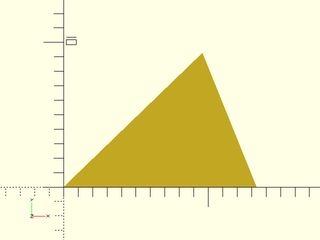
include <BOSL2/std.scad>
mask2d_chamfer(edge=10, mask_angle=44);
Example 12: 2D Chamfer Mask by edge, obtuse case
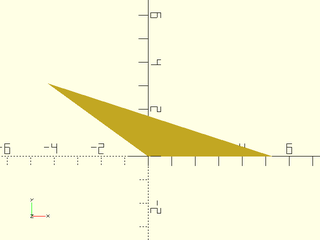
include <BOSL2/std.scad>
mask2d_chamfer(edge=10, mask_angle=144);
Example 13: 2D Chamfer Mask by edge and angle
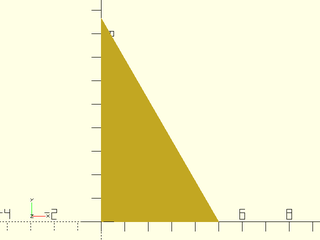
include <BOSL2/std.scad>
mask2d_chamfer(edge=10, angle=30);
Example 14: 2D Chamfer Mask by edge and x
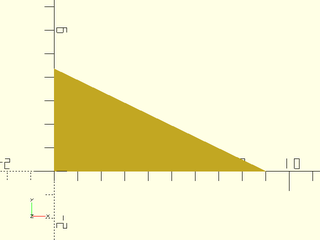
include <BOSL2/std.scad>
mask2d_chamfer(edge=10, x=9);
Example 15: 2D Inset Chamfer Mask
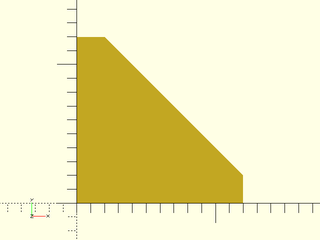
include <BOSL2/std.scad>
mask2d_chamfer(x=10, inset=2);
Example 16: 2D Inset Chamfer Mask on acute angle
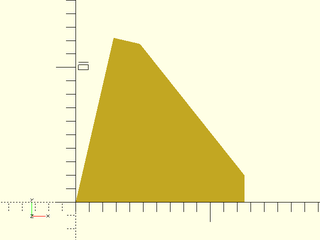
include <BOSL2/std.scad>
mask2d_chamfer(x=10, inset=2, mask_angle=77);
Example 17: 2D Inset Chamfer Mask on acute angle with flat top
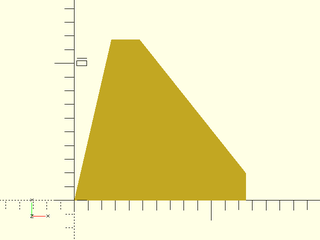
include <BOSL2/std.scad>
mask2d_chamfer(x=10, inset=2, mask_angle=77, flat_top=true);
Example 18: Masking by Edge Attachment
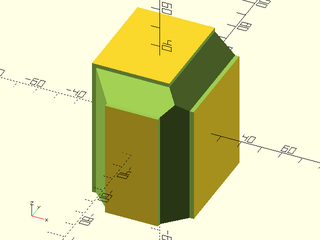
include <BOSL2/std.scad>
diff()
cube([50,60,70],center=true)
edge_profile([TOP,"Z"],except=[BACK,TOP+LEFT])
mask2d_chamfer(x=10, inset=2);
Example 19: Making an interior chamfer

include <BOSL2/std.scad>
%render() difference() {
move(-[5,0,5]) cube(30, anchor=BOT+LEFT);
cube(310, anchor=BOT+LEFT);
}
xrot(90)
linear_extrude(height=30, center=true)
mask2d_chamfer(edge=10);
Example 20: Chamfering an extreme prismoid by setting height
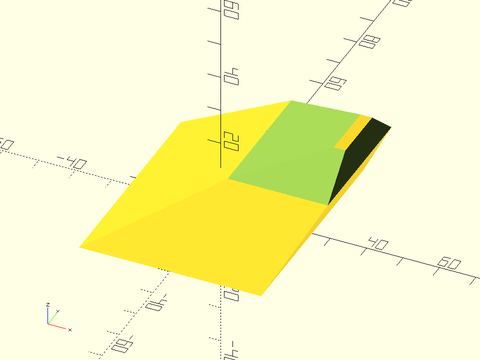
include <BOSL2/std.scad>
diff()
prismoid([50,60], [20,30], h=20, shift=[25,16])
edge_profile(TOP, excess=20)//let(f=$edge_angle)
mask2d_chamfer(h=5,mask_angle=$edge_angle);
Example 21: Chamfering an extreme prismoid with a fixed chamfer angle. Note that a very large chamfer angle is required because of the large obtuse angles.
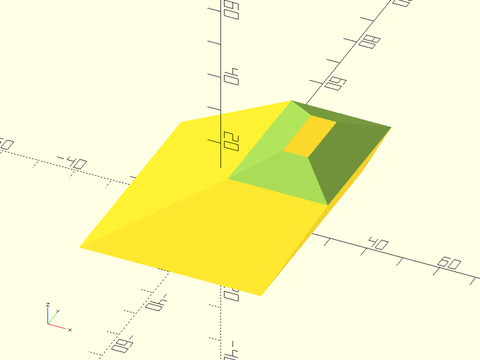
include <BOSL2/std.scad>
diff()
prismoid([50,60], [20,30], h=20, shift=[25,16])
edge_profile(TOP, excess=20)//let(f=$edge_angle)
mask2d_chamfer(h=5,mask_angle=$edge_angle,angle=64);
Example 22: Chamfering an extreme prismoid by setting height with inset and flat_top=true.
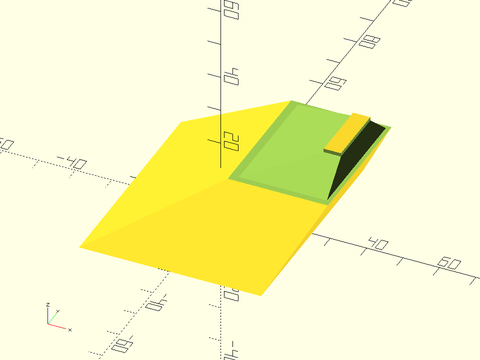
include <BOSL2/std.scad>
diff()
prismoid([50,60], [20,30], h=20, shift=[25,16])
edge_profile(TOP, excess=20)//let(f=$edge_angle)
mask2d_chamfer(h=4,inset=1,flat_top=true,mask_angle=$edge_angle);
Synopsis: Creates a rabbet mask shape. [Geom] [Path]
Topics: Shapes (2D), Paths (2D), Path Generators, Attachable, Masks (2D)
See Also: corner_profile(), edge_profile(), face_profile()
Usage: As Module
- mask2d_rabbet(size, [mask_angle], [excess]) [ATTACHMENTS];
Usage: As Function
- path = mask2d_rabbet(size, [mask_angle], [excess]);
Description:
Creates a 2D rabbet mask shape. When differenced away, this mask creates at the corner a rectanguler space of the specified size. This mask can be extruding into a 3D mask for an edge, or you can use that same extruded shape to make an interior shelf decoration between two walls. As a 2D mask, this is designed to be differenced away from the edge of a shape that with its corner at the origin and one edge on the X+ axis and the other mask_angle degrees counterclockwise from the X+ axis. If called as a function, returns a 2D path of the outline of the mask shape.
Arguments:
| By Position | What it does |
|---|---|
size |
The size of the rabbet, either as a scalar or an [X,Y] list. |
mask_angle |
Number of degrees in the corner angle to mask. Default: 90 |
excess |
Extra amount of mask shape to creates on the X and quasi-Y sides of the shape. Default: 0.01 |
| By Name | What it does |
|---|---|
anchor |
Translate so anchor point is at origin (0,0,0). See anchor. Default: CENTER
|
spin |
Rotate this many degrees around the Z axis after anchor. See spin. Default: 0
|
Side Effects:
- Tags the children with "remove" (and hence sets
$tag) if no tag is already set.
Example 1: 2D Rabbet Mask
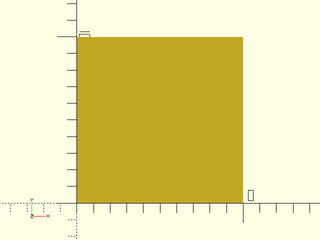
include <BOSL2/std.scad>
mask2d_rabbet(size=10);
Example 2: 2D Asymmetrical Rabbet Mask
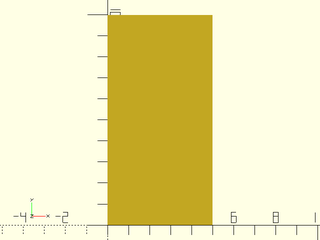
include <BOSL2/std.scad>
mask2d_rabbet(size=[5,10]);
Example 3: 2D Mask for a acute angle edge
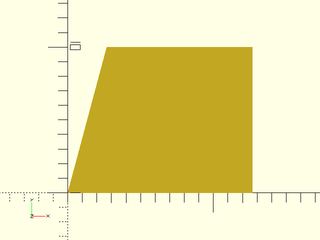
include <BOSL2/std.scad>
mask2d_rabbet(size=10, mask_angle=75);
Example 4: 2D Mask for obtuse angle edge. If the obtuse angle is too large the rabbet will not fit. If that happens, you will need to increase the rabbet width.
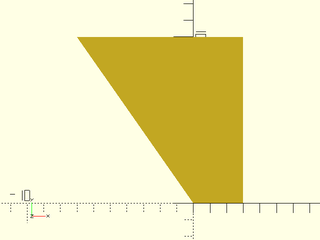
include <BOSL2/std.scad>
mask2d_rabbet(size=10, mask_angle=125);
Example 5: Masking by Edge Attachment

include <BOSL2/std.scad>
diff()
cube([50,60,70],center=true)
edge_profile([TOP,"Z"],except=[BACK,TOP+LEFT])
mask2d_rabbet(size=10);
Example 6: Making an interior shelf

include <BOSL2/std.scad>
%render() difference() {
move(-[5,0,5]) cube(30, anchor=BOT+LEFT);
cube(310, anchor=BOT+LEFT);
}
xrot(90)
linear_extrude(height=30, center=true)
mask2d_rabbet(size=[5,10]);
Synopsis: Creates a 2D dovetail mask shape. [Geom] [Path]
Topics: Masks (2D), Shapes (2D), Paths (2D), Path Generators, Attachable
See Also: corner_profile(), edge_profile(), face_profile()
Usage: As Module
- mask2d_dovetail(edge, angle, [inset], [shelf], [excess], ...) [ATTACHMENTS];
- mask2d_dovetail(width=, angle=, [inset=], [shelf=], [excess=], ...) [ATTACHMENTS];
- mask2d_dovetail(height=, angle=, [inset=], [shelf=], [excess=], ...) [ATTACHMENTS];
- mask2d_dovetail(width=, height=, [inset=], [shelf=], [excess=], ...) [ATTACHMENTS];
Usage: As Function
- path = mask2d_dovetail(edge, [angle], [inset], [shelf], [excess]);
Description:
Creates a 2D dovetail mask shape that is useful for extruding into a 3D mask for a 90° edge. Conversely, you can use that same extruded shape to make an interior dovetail between two walls at a 90º angle. As a 2D mask, this is designed to be differenced away from the edge of a shape that with its corner at the origin and one edge on the X+ axis and the other mask_angle degrees counterclockwise from the X+ axis. If called as a function, returns a 2D path of the outline of the mask shape.
Arguments:
| By Position | What it does |
|---|---|
edge |
The length of the edge of the dovetail. |
angle |
The angle of the chamfer edge, away from vertical. |
shelf |
The extra height to add to the inside corner of the dovetail. Default: 0 |
inset |
Optional amount to inset in perpendicular direction from each edge. Default: 0 |
mask_angle |
Number of degrees in the corner angle to mask. Default: 90 |
excess |
Extra amount of mask shape to creates on the X and quasi-Y sides of the shape. Default: 0.01 |
| By Name | What it does |
|---|---|
width |
The width of the dovetail (excluding any inset) |
height |
The height of the dovetail (excluding any inset or shelf). |
flat_top |
If true, the top inset of the mask will be horizontal instead of angled by the mask_angle. Default: true. |
anchor |
Translate so anchor point is at origin (0,0,0). See anchor. Default: CENTER
|
spin |
Rotate this many degrees around the Z axis after anchor. See spin. Default: 0
|
Side Effects:
- Tags the children with "remove" (and hence sets
$tag) if no tag is already set.
Example 1: 2D Dovetail Mask
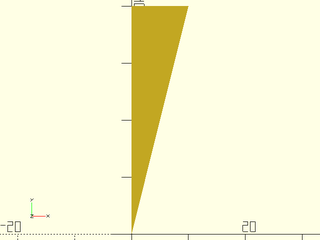
include <BOSL2/std.scad>
mask2d_dovetail(width=10,angle=14);
Example 2: 2D Dovetail Mask by height and slope. A slope of 1/6 is a common choice.
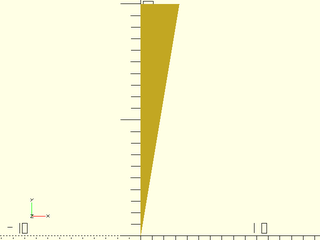
include <BOSL2/std.scad>
mask2d_dovetail(height=20, slope=1/6);
Example 3: 2D Inset Dovetail Mask to make the dovetail wider

include <BOSL2/std.scad>
mask2d_dovetail(width=5, angle=12, inset=[4,0]);
Example 4: 2D Inset Dovetail Mask on an obtuse angle
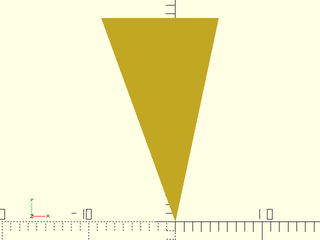
include <BOSL2/std.scad>
mask2d_dovetail(width=5, mask_angle=110, angle=12);
Example 5: 2D Inset Dovetail Mask on an acute angle will generally require an inset in order to fit.
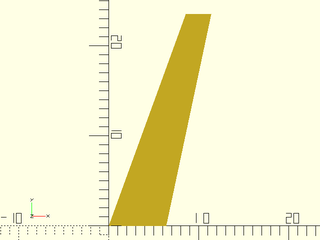
include <BOSL2/std.scad>
mask2d_dovetail(width=5, mask_angle=70, angle=12, inset=[6,0]);
Example 6: 2D dovetail mask by edge length and angle
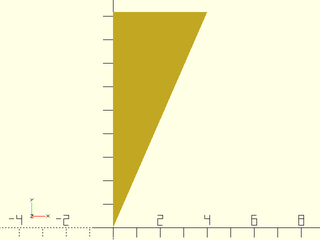
include <BOSL2/std.scad>
mask2d_dovetail(edge=10,width=4);
Example 7: 2D dovetail mask by width and height
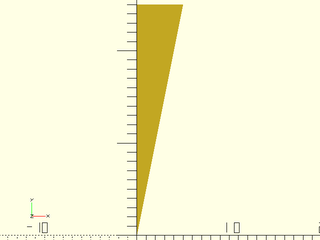
include <BOSL2/std.scad>
mask2d_dovetail(width=5,height=25);
Example 8: Masking by Edge Attachment
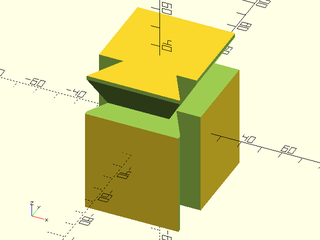
include <BOSL2/std.scad>
diff()
cube([50,60,70],center=true)
edge_profile([TOP,"Z"],except=[BACK,TOP+LEFT])
mask2d_dovetail(width=10, angle=30, inset=2);
Example 9: Making an interior dovetail
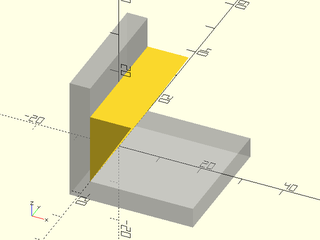
include <BOSL2/std.scad>
%render() difference() {
move(-[5,0,5]) cube(30, anchor=BOT+LEFT);
cube(310, anchor=BOT+LEFT);
}
xrot(90)
linear_extrude(height=30, center=true)
mask2d_dovetail(width=10,angle=30);
Synopsis: Creates a 2D ogee mask shape. [Geom] [Path]
Topics: Shapes (2D), Paths (2D), Path Generators, Attachable, Masks (2D)
See Also: corner_profile(), edge_profile(), face_profile()
Usage: As Module
- mask2d_ogee(pattern, [excess], ...) [ATTAHCMENTS];
Usage: As Function
- path = mask2d_ogee(pattern, [excess], ...);
Description:
Creates a 2D Ogee mask shape that is useful for extruding into a 3D mask for a 90° edge.
Conversely, you can use that same extruded shape to make an interior ogee decoration between two walls at a 90º angle.
As a 2D mask, this is designed to be differenced away from the edge of a shape that with its corner at the origin and one edge on the X+ axis and the other mask_angle degrees counterclockwise from the X+ axis.
Since there are a number of shapes that fall under the name ogee, the shape of this mask is given as a pattern.
Patterns are given as TYPE, VALUE pairs. ie: ["fillet",10, "xstep",2, "step",[5,5], ...]. See Patterns below.
If called as a function, returns a 2D path of the outline of the mask shape.
| Type | Argument | Description |
|---|---|---|
| "step" | [x,y] | Makes a line to a point x right and y down. |
| "xstep" | dist | Makes a dist length line towards X+. |
| "ystep" | dist | Makes a dist length line towards Y-. |
| "round" | radius | Makes an arc that will mask a roundover. |
| "fillet" | radius | Makes an arc that will mask a fillet. |
Arguments:
| By Position | What it does |
|---|---|
pattern |
A list of pattern pieces to describe the Ogee. |
excess |
Extra amount of mask shape to creates on the X- and Y- sides of the shape. Default: 0.01 |
| By Name | What it does |
|---|---|
anchor |
Translate so anchor point is at origin (0,0,0). See anchor. Default: CENTER
|
spin |
Rotate this many degrees around the Z axis after anchor. See spin. Default: 0
|
Side Effects:
- Tags the children with "remove" (and hence sets
$tag) if no tag is already set.
Example 1: 2D Ogee Mask
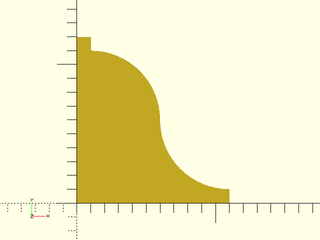
include <BOSL2/std.scad>
mask2d_ogee([
"xstep",1, "ystep",1, // Starting shoulder.
"fillet",5, "round",5, // S-curve.
"ystep",1, "xstep",1 // Ending shoulder.
]);
Example 2: Masking by Edge Attachment
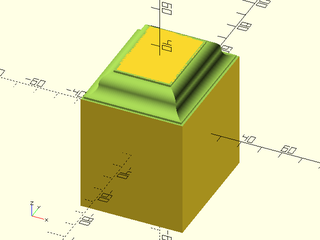
include <BOSL2/std.scad>
diff()
cube([50,60,70],center=true)
edge_profile(TOP)
mask2d_ogee([
"xstep",1, "ystep",1, // Starting shoulder.
"fillet",5, "round",5, // S-curve.
"ystep",1, "xstep",1 // Ending shoulder.
]);
Example 3: Making an interior ogee
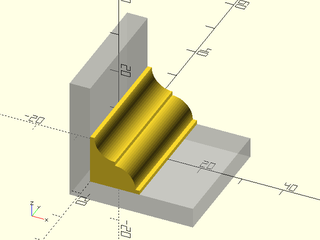
include <BOSL2/std.scad>
%render() difference() {
move(-[5,0,5]) cube(30, anchor=BOT+LEFT);
cube(310, anchor=BOT+LEFT);
}
xrot(90)
linear_extrude(height=30, center=true)
mask2d_ogee([
"xstep", 1, "round",5,
"ystep",1, "fillet",5,
"xstep", 1, "ystep", 1,
]);
Table of Contents
Function Index
Topics Index
Cheat Sheet
Tutorials
Basic Modeling:
- constants.scad STD
- transforms.scad STD
- attachments.scad STD
- shapes2d.scad STD
- shapes3d.scad STD
- drawing.scad STD
- masks2d.scad STD
- masks3d.scad STD
- distributors.scad STD
- color.scad STD
- partitions.scad STD
- mutators.scad STD
Advanced Modeling:
Math:
- math.scad STD
- linalg.scad STD
- vectors.scad STD
- coords.scad STD
- geometry.scad STD
- trigonometry.scad STD
Data Management:
- version.scad STD
- comparisons.scad STD
- lists.scad STD
- utility.scad STD
- strings.scad STD
- structs.scad
- fnliterals.scad
Threaded Parts:
Parts:
- ball_bearings.scad
- cubetruss.scad
- gears.scad
- hinges.scad
- joiners.scad
- linear_bearings.scad
- modular_hose.scad
- nema_steppers.scad
- polyhedra.scad
- sliders.scad
- tripod_mounts.scad
- walls.scad
- wiring.scad
STD = Included in std.scad